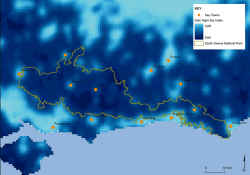
The south east is one of the most light-polluted areas in the UK, with street and outdoor lighting affecting the dark night skies. The orange skyglow from our towns and cities can be seen for miles around. Only a small per cent of the region can be called ‘truly dark’ and in many areas the stars can not be seen at all due to light pollution. This shows that there is a lot of waste of energy and makes it more difficult for us to view the night sky. Modern street lighting in towns and cities can really help this issue by casting a different kind of light and dimming or turning off later in the evening.
Light pollution also causes lots of problems for nocturnal animals, affecting their ability to find food and remain undetected by predators.
There are a few pockets of true dark night skies within the National Park and these are very important. In areas where dark night skies remain, the National Park is the ideal place to experience the best free light show there is, with twinkling stars, whizzing comets and bright planets scattered across the sky.
We all have a part to play in improving our night time environment. Join us on the journey to find out if the South Downs National Park can join Exmoor and Brecon Beacons in being Dark Sky Reserves.
Resources Toolbox
General Interest
All Ages
-

CfDS Dark Sky Guide for Young Adults
A guide to light pollution and it's effects. Find out how you can get involved to reduce light pollution and see the stars. -

CfDS Lighting guidelines
Guidance from the lighting experts of the Campaign for Dark Skies. Advice to save money, increase health and safety, and minimise light pollution -

Guess the Constellation
A game that challenges you to find the star pattern, reveal the mythical figure and find out their astronomical secrets. Which constellation has something to do with little green men? -

International Dark Sky Reserve Program
Details on becoming a dark sky reserve: a large area of high quality dark skies with associated partnerships that has managed to minimize light pollution. -

Light pollution: the good, bad and ugly
A simple presentation showing examples of lights and potential light pollution problems. -

SDNP A Dark Skies Reserve in the making
A summary of the short term plan for 2013: finding out how dark the skies are in the National Park. -

The UKs best places to see dark skies
Map showing areas where the skies are dark and there is a good chance of clear weather.
Key Stage 1
Ages 5–7
Years 1 and 2
Key Stage 3
Ages 11–14
Years 7, 8 and 9
HE & FE
Higher and Further Education





